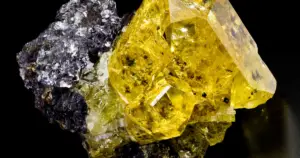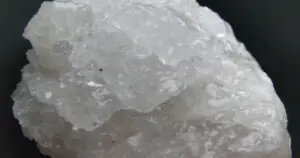Thomsonite Meaning: Healing Properties, Benefits and Uses
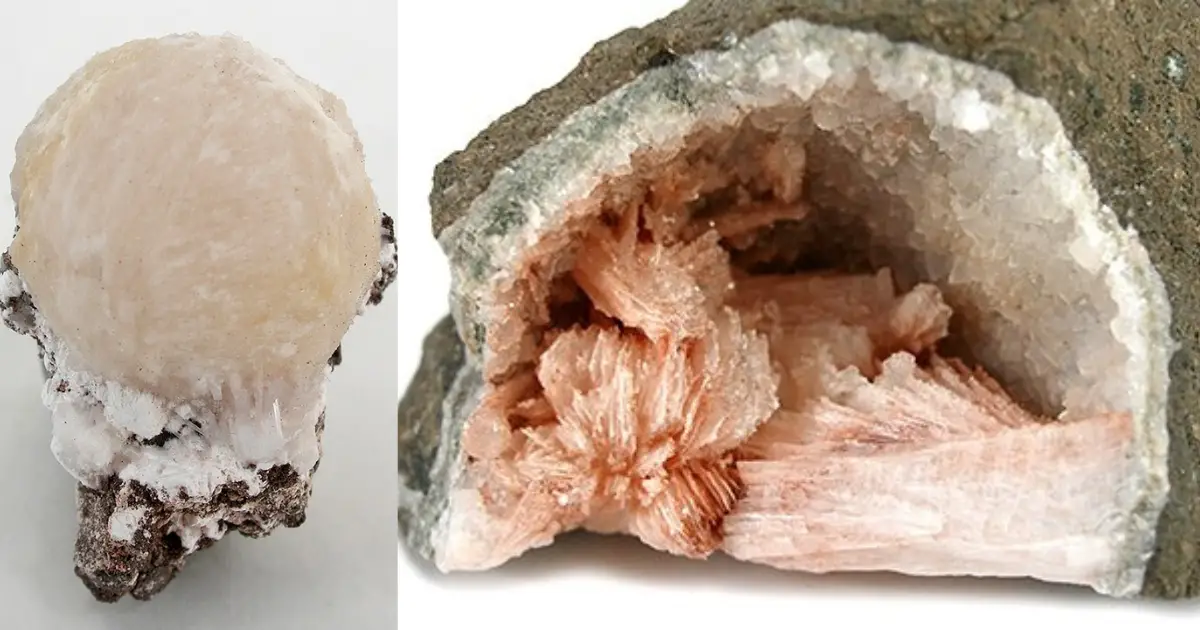
Thomsonite’s distinctive appearance will call to you if its symbolic meaning of balance and growth doesn’t. It’s time to give this exceptional zeolite crystal the attention it deserves! A crystal that’s been drifting under the radar unnoticed for way too long is this strange zeolite.
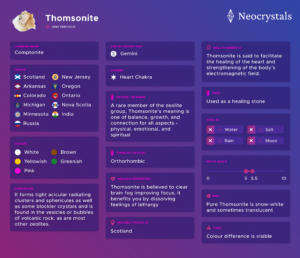
Table of Contents
What is Thomsonite?
Thomsonite is the term given to the tectosilicate minerals that make up the zeolite group. Thomsonite was once known as a mineral species, but the International Mineralogical Association reclassified it in 1997 and gave it the designation of a series, with the mineral species now known as thomsonite-Ca and thomsonite-Sr. The most prevalent of the two, Thomsonite-Ca, is hydrous sodium, calcium, and aluminum silicate with the formula NaCa2Al5Si5O20·6H2O. Calcium can be replaced with strontium, and the name of the species depends on the prevailing element. In cases where testing has not been conducted due to the species’ visual similarity, thomsonite is employed instead.
How to Identify a Thomsonite?
The name of this gem, thomsonite, honors its discoverer, Dr. Thomas Thomson, like the names of many other gems. In 1840, after discovering a deposit in Scotland’s Kilpatrick Hills, he published the first description of the mineral.
Thomson is thought to have discovered and studied the mineral for the first time in Dumbaronshire, a historic county in central-western Scotland regarded as the mineral’s actual type locality. Newton Winchell founded the Minnesota Geological Survey almost three decades later. Two of his students, bright young scholars from the University of Minnesota, explored the local rocks while on vacation near the north coast of Lake Superior in 1879. In 1888, they published a report that contained details on the first time thomsonite was mentioned in America.
- Thomsonite Cuts
Because of its hardness, cutting gems from the homesite is difficult. The smallest hammer blow can break a pricey specimen. It is also susceptible to the frequencies produced by a grinding wheel, which frequently results in gems breaking. Therefore, accurate Thomsonite stone cutting demands a skilled lapidary with years of education and practice. This raises the cost of cutting Thomsonites as well.
Though they are rare, faceted thomsonite can be found on the market. The likelihood of finding thomsonite carved en cabochon is substantially higher. Thomsonite that has not been cut is also generally accessible. The size and type of minerals a stone contain and its composition affect the price.
- Thomsonite Shapes
Thomsonite deposits are typically small. Even in their most prevalent locality, the majority of specimens aren’t much larger than a pea. Thomsonite gems are often priced in carats. But raw thomsonite is typically priced in grams as opposed to carats. On occasion, vendors will include both in addition to the stone’s dimensions.
Where is Thomsonite Found?
Using lava flows, thomsonite was created as far back as the Keweenawan Period, or more than 600 million years ago! The stone is typically found in amygdaloidal igneous rocks and lava cavities. Amygdaloids are vesicles and cavities on a rock that have filled with a secondary mineral long after the lava has cooled (similar to the formation of chalcedony).
Gases trapped inside the lava and cracks between the lava flows evolved into hollow apertures as the lava cooled and hardened (or amygdules). Thomsonite was produced when these empty pockets filled up and cemented over hundreds of thousands of years.
Thomsonite Stone Meaning
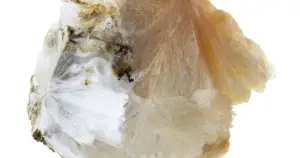
The zeolite category only contains the uncommon substance Thomsonite. In 1820, Thomas Thomson, a Scottish chemist who found the stone in west-central Scotland’s Kilpatrick Hills, gave it that name. Thomsonite is frequently used for beads even though it is rarely cut as a gem. It is occasionally carved into cabochons for rings.
Site-based separation of Thomsonite from other fibrous zeolites is challenging. Although acicular (needle-shaped) crystals are the most common type, tabular, spherical, and fibrous crystals can also exist. A specimen can be white, red, purple, green, or yellow. Collectors prize the colored stones because of their porcelain-like brilliance.
Thomsonite is typically found near calcite, quartz, and stilbite. It arises in lava cavities and is a byproduct of nepheline’s disintegration. Major thomsonite-producing regions include Flinders, Victoria, Australia; Severocesky Kraj, Bohemia, Czech Republic; Eifel Mountains, Rhine-Palatinate, Germany; Kaipara, North Island, New Zealand; Kola Peninsula, Russia; and Invernesshire, Scotland. Sardinia, Italy is another important region. Highly regarded thomsonite specimens can be discovered in the United States on the coasts of Lake Michigan and Lake Superior, particularly in Keweenaw County, Michigan.
Thomsonite Meaning in Ancient Lore and History
The historic Thomsonite Beach Motel and Jewelry Shop, now known as the Thomsonite Beach Inn & Suites, opened in 1962 along Route 61, six miles south of the Minnesotan town of Grand Marais and next to a gem-mining business. The first owners, Tania, and Maurice Feigal were ardent rockhounds and lapidary experts. Along with providing accommodations, they established the ongoing custom of creating and selling gold and silver thomsonite jewelry. In 1998, the Feigals sold the house. Thomsonite might not have been as well-known in the region today if it weren’t for the Fiegals, according to the current owner Lee and Scott Bergstrom.
In Scottish material, Thomsonite was discovered for the first time in 1820. It bears the name Thomas Thomson after the Scottish chemist. Thomsonite has an orthorhombic crystal structure. Mohs hardness ranges from 5 to 5.5. It has a density between 2.3 and 2.4 and is transparent to translucent. It could be neutral in tone, white, beige, or just a little bit green, yellow, or red. The crystals are typically long, thin blades that occasionally form fans and tufts as well as radial clusters. The aggregates can have a variety of appearances, including spikey, thick, ball-like, or worm-like growths. Spherical and tight acicular radiating clusters are frequent types.
In addition to basaltic volcanic rocks, granitic pegmatites occasionally include thomsonite together with other zeolites. Along the shore of Lake Superior, large thomsonite nodules with enticing banded colors can be found. The majority of these thomsonite nodules and the stones that they produce are a little larger than 0.6 cm. It is very challenging to extract those contained in basalt without damaging them. As a result, a sizable portion of those utilized as gemstones come from pebbles that have been gathered from beaches.
Thomsonite Crystal Properties
characteristics of gemstones let you know the value of a diamond. Thomsonite’s value is influenced by all of the typical attributes used in the industry: color, clarity, cut, and carat weight. Pure thomsonite often ranges in color from tan to white to translucent. Colorations in the gem, such as pink, red, or brown, are brought on by impurities of other substances (such as ferric/ferrous iron or copper).
Some varieties range from green to blue to nearly colorless. The majority of thomsonite for sale typically has several hues in a single piece. They frequently exhibit banded, colorful, radiating rings. The ones with the greenest, grey or black occurrences are frequently the most in demand.
Thomsonite gems can occasionally display chatoyancy, or the “cat’s eye” effect. To put it another way, these jewels exhibit a distinct, vivid line of reflected light inside, much like how a cat’s eye becomes a sharp slit when exposed to strong light. The rarity of the phenomenon increases the value of these jewels. The clarity in Thomsonite contains a diverse array of inclusions, the most prevalent of which is copper or iron. Usually, the value is higher the more pronounced the contrast.
Thomsonite Healing Properties
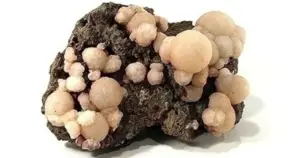
There is much to learn about the fundamentals of healing stones, but they are used for relaxing, grounding, and energizing purposes. And such has been the tale ever since the dawn of time. While true Thomsonite can be found in Michigan’s Keweenaw Peninsula, it usually has little to do with copper. Similar to minerals like tanzanite, thomsonite is a zeolite.
Our oldest ancestors employed healing gemstones as natural medicines in the distant past. How is it possible for a modest stone to hold a powerful vibrational current of healing energies? In traditional Chinese medicine, healing stones encourage the movement of Qi, the good life force energy also known as Prana in Hinduism.
To access a higher frequency of mindfulness, self-acceptance, and inner serenity, the technique is derived from ancient Hindu and Buddhist philosophies that rely on the natural world. Crystals have been around since 4500 BC when the Ancient Sumerians discovered and recorded them in enchanted serums and elixirs. Healing stones made their way into ancient Egyptian, Mexican, and Greek societies as human civilization advanced.
The history of healing crystals is extensive and varied, including uses as navigational aids, combat armor, medicinal talismans, conduits to the heavenly gateway, and royal baubles. Each form of crystal has its unique qualities, but they all have the same healing and consciousness- and intuition-enhancing effects.
Although the procedure was a crucial component of prehistoric custom, it wasn’t until the early 17th century that it made its way into modern medicine after a German astronomer saw the perfect symmetry of snowflakes. The first mathematical formula for crystallography was created by Johannes Kepler as a packed spherical structure, and he described his discovery as a “six-cornered snowflake.”
Thomsonite Metaphysical Properties
Thomsonite crystals belong to the zeolite family, and they share many characteristics with other zeolites in terms of their physical characteristics. are particularly beneficial to aid in the body’s elimination of pollutants. The ability of Thomsonite to combine your emotions and your thinking is among its other qualities. It might improve your mental clarity and be beneficial if you have brain fog.
Thomsonite Benefits
It has been said that this mineral’s stones offer therapeutic properties for the body, mind, and spirit. If you’re fortunate enough to be able to keep one close by, you might get a chance to witness some of its enchantment.
Physical Benefits of Thomsonite
When using crystals for healing, you should use the same caution that you would with any other crystal. Crystal healing should never be used in place of conventional medical care. Keep in mind that crystals are auxiliary healers.
- Detoxification – The detoxifying properties of Thomsonite are well established. It can support the body, mind, and spirit in getting rid of poisons and pollutants. Addictions and other compulsive behaviors are also thought to respond well to this gemstone’s therapeutic properties.
- Urogenital system – Additionally, problems with the kidneys and bladder can be treated using Thomsonite. It is said to aid in detoxifying and help the kidneys remove toxins.
- Metabolism – According to legend, Thomsonite can help increase metabolism. It is believed to boost energy levels and enable the body to utilize food more effectively.
Spiritual Benefits of Thomsonite

It is also believed that Thomasine has a lot of spiritual advantages. They consist of the following:
- Protection – The protecting qualities of the Thomsonite are well known. It is believed to be very effective at driving away evil spirits. The stone is thought to be beneficial in protecting you from harmful influences and energy.
- Psychic Power – According to legend, Thomsonite can improve psychic skills. It is said to enhance mental focus and clarity as well as psychic sensitivity.
- Grounding – A great stone for meditation is thomsonite. It is believed to encourage calmness and inner serenity and to facilitate communication with your higher self.
Thomsonite Birthstone
Thomsonite is a favorable zodiac stone for Gemini signs even if it isn’t a recognized birthstone. It is thought to enable individuals to focus on their genuine selves by balancing their complex personalities.
More of an attractive crystal, the Thomsonite is favored by knowledgeable gem enthusiasts. Not that you can’t find some Thomsonite jewelry, though! In contrast to more well-known jewels, your options could be a little more constrained. You can determine precisely what crystal you’re working with by evaluating the physical characteristics of the mineral. Let’s now discover how to recognize thomsonite!
Thomsonite Chakras

The Sacral, Crown, and Heart chakras can be opened and resonated with by the Thompsonite stone. When they are engaged and aligned, you might observe what follows:
- Salivary Chakra – The sacral chakra is located at the base of the spine. It’s associated with sexuality, creativity, and pleasure. When this chakra is open and balanced, you will feel confident and sexual. You’ll be able to indulge your senses and express yourself creatively.
- Head Chakra – The Crown chakra is located at the top of the head. It is linked to knowledge, intuition, and a connection to the spiritual world. You’ll feel spiritually connected and in tune with your intuition when this chakra is open and balanced. You’ll be able to access your inner guidance and wisdom.
What are the Uses of Thomsonite?
After locating it in Scotland’s Kilpatrick Hills, Dr. Thomas Thomson, for whom Thomsonite is called, originally identified the mineral in 1840. Thomsonite stones have several uses.
Thomsonite beads are very popular and used for a variety of purposes, especially in jewelry. It also helps in maintaining a spiritual balance. To know more about its uses, refer to the properties stated below.
Caring for Thomsonite

The care of gemstones can be difficult. Fortunately, thomsonite is a low-maintenance stone. However, when handling your stones, you should always take extra precautions. To clean your Thomsonite, use lukewarm water, mild soap, and a soft, non-abrasive cloth. Wipe away any dirt or debris with a soft cloth before patting it dry. Avoid letting things air dry to avoid staining your diamond.
Thomsonite jewelry shouldn’t be worn while engaging in high-impact activities, and your rings should have a protective setting.
Keeping your Thomsonite away from:
- harder minerals and jewels
- corrosive substances and acids
- high-frequency cleaners (steam or ultrasonic)
- sudden variations in temperature
Thomsonite should be stored separately from other gems in a soft pouch or fabric-lined box once you have finished wearing or using it.
How much is Thomsonite worth?
Thomsonite is not only the rarest of the zeolites, but it is also stated that thomsonite gemstones are even rarer than diamonds, sapphires, emeralds, and even rubies. Thomsonite gems typically command greater prices as a result. Contrary to some others, it’s still a jewel that’s rather easy to find.
The typical price range for homesite cabochons is $1.60 to $4.70 per carat. Given that faceted thomsonite is so uncommon, its cost has increased significantly. The price range for these diamonds is from $22 to $65 per carat. Rough Thomsonite is inexpensive and widely available. They range in price from $0.45 to $2.00 per gram on average. Higher-quality specimens may be more expensive.
Although homesite jewelry is rare, there are some excellent examples available. Thomsonite bracelets are typically priced between $20 and $80. Ring prices range from about $150 to $340, with some rings being as low as $50. Pricing varies depending on the metals and gem combinations used in each design.
Does Thomsonite make a good Jewelry Stone?
Thomsonite is a pretty pink stone that occasionally has chatoyant sprays and “eyes.” A little region on the north shore of Lake Superior close to Grand Marais, Minnesota, has long been known as the best. Thomsonite stones continue to roll up on the beach close to Grand Marais even though the collecting area in that region has been off-limits to the public for many years. The problem is that most coastal real estate is owned by private individuals.
The majority of what we once referred to as Thomsonite from the Upper Peninsula is copper-bearing Prehnite, also known as Patricianite at times. If you discover what you think is Thomsonite and it has traces of copper, it’s most likely Prehnite. Prehnite has many inclusions that produce beautiful pastel colors. Both “eyes” and feathery patterns of the variegated kind are frequently seen.
Summary of Thomsonite
| Name of Crystal | Thomsonite |
| Precious | No |
| Semi Precious | Yes |
| Other Names | Comptonite |
| Origin(s) | Scotland, Arkansas, Colorado, Michigan, Minnesota, New Jersey, Oregon, Ontario, Nova Scotia, India, Russia |
| Color(s) | White, Yellowish, Pink, Brown, Greenish |
| Formation | It forms tight acicular radiating clusters and sphericules as well as some blockier crystals and is found in the vesicles or bubbles of volcanic rock, as are most other zeolites. |
| Majorly Found at | Scotland |
| Zodiac Suited for | Gemini |
| Chakra | Heart Chakra |
| Crystal Meaning | Thomsonite is one of the rarer zeolites. It forms tight acicular radiating clusters and sphericules as well as some blockier crystals and is found in the vesicles or bubbles of volcanic rock, as are most other zeolites. |
| Types of Crystal | Orthorhombic |
| Healing Properties | Thomsonite is believed to clear brain fog improving focus, it benefits you by dissolving feelings of lethargy |
| Health Benefits | Thomsonite is said to facilitate the healing of the heart and strengthening of the body’s electromagnetic field. |
| Uses | Used as ahealing stone |
| Goes in Water? | No |
| Goes in Salt Water? | No |
| Goes in Rain Water? | No |
| Goes in Moon Water? | No |
| Moh’s Scale | 5 – 5.5 |
| Real | Pure Thomsonite is snow-white and sometimes translucent |
| Fake | Color difference is visible |
FAQs
Where is Thomsonite found?
Locally, Thomsonite can be found on the shores between Lutsen and Grand Marais, on Isle Royal in Michigan, and the Keweenaw Peninsula of Michigan close to Saxon Falls and the Montreal River Gorge.
What is Thomsonite worth?
According to Keith, the price range for these thomsonites is often between $5 and $20 per gram. The linear fractures, “eyes,” and greenish tones are the three key characteristics that determine the price of this gem.
How do I identify my Thomsonite?
Thomsonite Specifications and Features
- NaCa2Al5Si5O20 is the chemical formula (H2O)
- Zeolite group, a family of minerals.
- Tectosilicates make up its makeup.
- Mohs scale hardness: 5–5.5.
- Uncolored, yellow, white, greenish-yellow, and pink.
- Orthorhombic crystal structure.
- Vitreous to pearly luster.
- From transparent to opaque is transparency.
Where can I find Thomsonite in Minnesota?
Thomsonite from Minnesota is distinctive due to its color and texture because gem-quality stones are only found in a small region of Lake Superior’s shoreline, around 5 12 miles southwest of Grand Marais.
What is Thomsonite good for?
are particularly beneficial to aid in the body’s elimination of pollutants. The ability of Thomsonite to combine your emotions and your thinking is among its other qualities. It might improve your mental clarity and be beneficial if you have brain fog.

